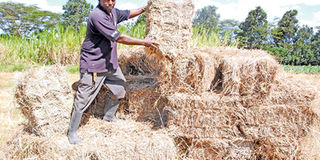A comprehensive guide to fodder selection

Samwel Mambo showcases bales of Boma Rhodes in his farm in Rongai, Nakuru County. Seeds for most fodders can be acquired from Kenya Agriculture and Livestock Research Organisation (Kalro) and Agricultural Training Centre (ATC) stations across the country. PHOTO | JOHN NJOROGE | NMG
What you need to know:
- Fodder is termed as good if it has high yield of dry matter (DM), crude protein (CP) and total digestible nutrients (TDN).
- These values vary depending on specific fodder, season and the age of the plant.
- Due to agro-ecological limitations, there is no universal fodder and, therefore, selection of a good fodder is paramount.
- However, seeds for most fodders can be acquired from Kenya Agriculture and Livestock Research Organisation (Kalro) and Agricultural Training Centre (ATC) stations across the country.
It is estimated that milk production across the country is between 1,300kg and 4,575kg per cow, per year from the various dairy breeds.
The variation in production is attributed to the availability of high quality feeds, differences in animal breeds and the production system, which in turn is influenced by agro-ecological zones.
This production per animal is low as compared to the world’s best of 9,000 kilos or litres per year. However, in Kenya, studies have revealed that the genetic potential of dairy cattle is far much higher than the milk production.
This implies that good management coupled with quality feeds are the key to increased production. On feeds, a dairy animal consumes 3 per cent of its body weight of dry matter and from the 3 per cent, fodder constitutes about 98 per cent (estimate for an adult; 60-100kg, concentrates -2.2kg and mineral supplements -100-150g).
Utilisation of high quality fodder not only leads to high yields but also lowers costs since feeds make up to 70 per cent of the production costs in a dairy system.
Fodder is termed as good if it has high yield of dry matter (DM), crude protein (CP) and total digestible nutrients (TDN).
These values vary depending on specific fodder, season and the age of the plant. Further, fodder with good conserving qualities is even superior as it assists in addressing seasonal fluctuation of feed availability and, therefore, milk production.
Due to agro-ecological limitations, there is no universal fodder and, therefore, selection of a good fodder is paramount.
Although there are many fodder seed producing companies, the perennial nature of the plants and their ability to regrow limits some of the firms production potential.
However, seeds for most fodders can be acquired from Kenya Agriculture and Livestock Research Organisation (Kalro) and Agricultural Training Centre (ATC) stations across the country.
The following is a comprehensive guide on all fodders available in the country. Know which fodder to grow, where, why, expected dairy output and some of the demerits of growing it.

A comprehensive guide on all fodders available in the country. Know which fodder to grow, where, why, expected dairy output and some of the demerits of growing it. TABLE | COURTESY
While the guide addresses dairy, it can be applied to other livestock, rabbits and poultry.




